
“Somewhere Else,” a project of California-based artist Jane Szabo, is a constructed tableau that transports the viewer away to another time, place, or mood. The visual expression of “Somewhere Else” places the artist, in her own mind, where she would rather be, as an alternative to where she is at that present moment. Szabo uses visual cues to carry the viewer away, using the physical attributes of a constructed house of maps within a chosen stage. With these images, the artist triggers within us a feeling of transition and transformation.
The expression “Somewhere Else” carries a particular meaning within our lexicon; it expresses a wish to be in a place other than our current one, whether physically, emotionally, or spiritually. What does the artist intend to convey through the act of constructing a model of a home from maps and placing it in various settings? The maps, used as the side panels or roof shingles for these house, are all of distinctive places, showing roads, rivers, and lakes. She constructs a house of maps that is unique to each of those locations, but which “harken back to places” she explored as a child or to other memories as an adult.
Maps themselves are often used as art or have been reproduced in an artistic manner. Artist Guillermo Kuitca painted maps of Europe on child-sized beds in his “Sin Titulo, 1992”. People are fascinated with maps, and view or use them daily. Here, the maps symbolize travel to a place. But, for Szabo, it is not place in particular. It is a symbolic reference of the need to be elsewhere. It is a suggestion that maybe we cannot follow a map to where we want to be. The landscape, or private interior space, which Szabo chooses is part of the visual description of where she imagines herself being, living, existing, or working. To fulfill and share this fantasy, Szabo travels to different locations to capture a moment. Rather than simply pointing her lens at what is real, the photographer creates a reality and invites the viewer into it.
Constructing and staging narratives have a long tradition in the arts, and particularly in photography. Staging can be defined as a constructed scene. Staging can also be defined as the act of presenting a play or performance. Even though no human figures appear in Szabo’s images, the house acts as the performer on the stage. Each constructed house is unique, as is each location. Like any other director, Szabo chooses where to place the house on the stage depending on the message she wants to communicate. Whether in the foreground or background, or positioned to the right or center or left, the placing of the house suggests how the artist may want us to relate to the tableau.
There is precedent for arranging and constructing a still life or performance where the photograph becomes the object of art. A prior commentary, “Constructed Images – Paris Photo 2017, 12/14/2017” by Foto Relevance describes work of Thomas Demand, Lori Nix, Sandy Skoglund and others who each constructed a space to set a mood or communicate a message in very different ways. The Museum of Contemporary Photography (MoCP) at Columbia College Chicago published an article, “Constructed and Staged Images (Fall 2018)” , in which they discuss the work of several artists, including Sarah Hobbs. Describing the staged photographic work of Hobbs, they state: “For her “Small Problems in Living,” series, Sarah Hobbs researches phobias and obsessive-compulsive disorders to stage scenes to photograph in her home studio that picture distinct human behaviors. Ranging in subjects from claustrophobia to vanity, Hobbs constructs acute tableaux within domestic settings…These neuroses and mental disturbances manifest themselves in objects cluttering otherwise sparsely furnished rooms, multiplied to overtake if not quite overwhelm the space. There is just enough space left to allow the room an occupant, though one is never pictured.” Hobbs’s staging is similar in style to Szabo’s in “Somewhere Else.” Like in Hobbs’s works, no human figures appear in Szabo’s images. Like Hobbs, Szabo is creating visualizations for us of her inner feelings and needs. The Guggenheim writes about the staged works of Gregory Crewdson: “In his early work he created dioramas, photographed them, and then dismantled them. Later, he staged full real life production scenes fabricating spaces and creating atmosphere in lighting and staging.” While Szabo’s scenes are less elaborate, there is a common spirit of transition and transportation of the viewer that is shared with Crewdson and these other artists.
The current issue of Aperture (#237) features an article “Spirituality is Solidarity;” a conversation between Wolfgang Tillmans and Martin Hägglund about photography and “social connection.” Tillmans responds: “Art is not, and photography in not, just a depiction of a kind of reality; they are also a new reality in their very existence. They not only speak about something, but are actual things, objects that do something new entirely and something that the depicted subjects don’t do on their own. So there is an act of transformation happening, which is not just recording.” This comment resonates with what Szabo is doing in creating her diorama.
Szabo’s background as a model maker gives her the creative skills and freedom to make these props. The staging which Szabo chooses varies from landscapes to interiors. The landscapes range from deserts to mountains to beaches, and the time of day varies from early morning to the dark of night. The interiors are lush yet sparse and leave you wondering what lies just outside the frame. Szabo uses this staging to evoke emotion. The “somewhere” may be a sense of dread, somberness, confidence, or destiny. Certain images may visualize our own sense of being, a wish to be “elsewhere” and to feel differently—there, in the place where Szabo has set the house.
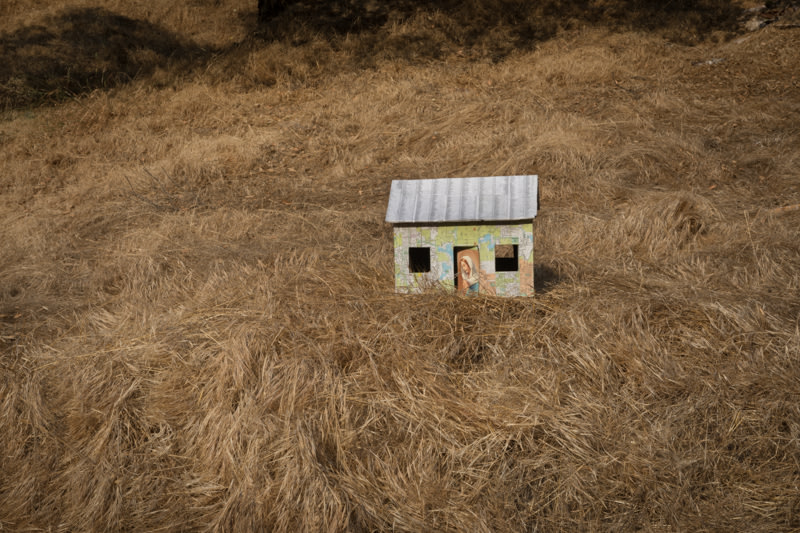
© Jane Szabo, July 15, El Prieto (2018)
When the house is placed near the center of the image, as in “July 15, El Prieto,” it creates the feeling that we have reached an intended destination after a long journey. A house in a field of dry grass gives a sense of winter approaching. A place of solitude. Upon close examination, we see the image of a woman with saintly halo in prayer, possibly the Virgin Mary. Does the artist intend for us to consider this particular “somewhere else” to carry a religious significance? A place for quiet introspection? Or is it a desire for a home governed by a deep religious belief or a semblance of sanctuary? In the chaotic world in which we live, with its daily barrage of evil and violence, perhaps this image offers an imaginary space to escape to and live in a more peaceful world where we can believe in something better.
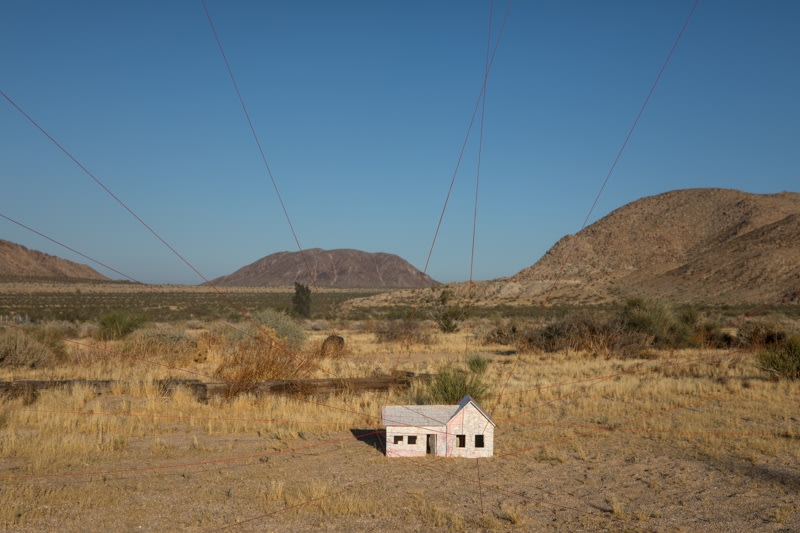
© Jane Szabo, June 7, Fault Lines (2019)
The image “June 7, Fault Lines” features a house tied down by red string connected to unseen supports, as in a spider’s web. The valley and it hills in the background, along with the title, “fault lines,” leads one to believe that the ground under this house in unstable and earthquake prone. This may be a constant worry for anyone who shares the California region with this artist. Rather than imagining “somewhere else,” the voice in this images yells to be any place but here. Alternatively, this may be an analogy for an internal feeling of a shift in thought or emotion.
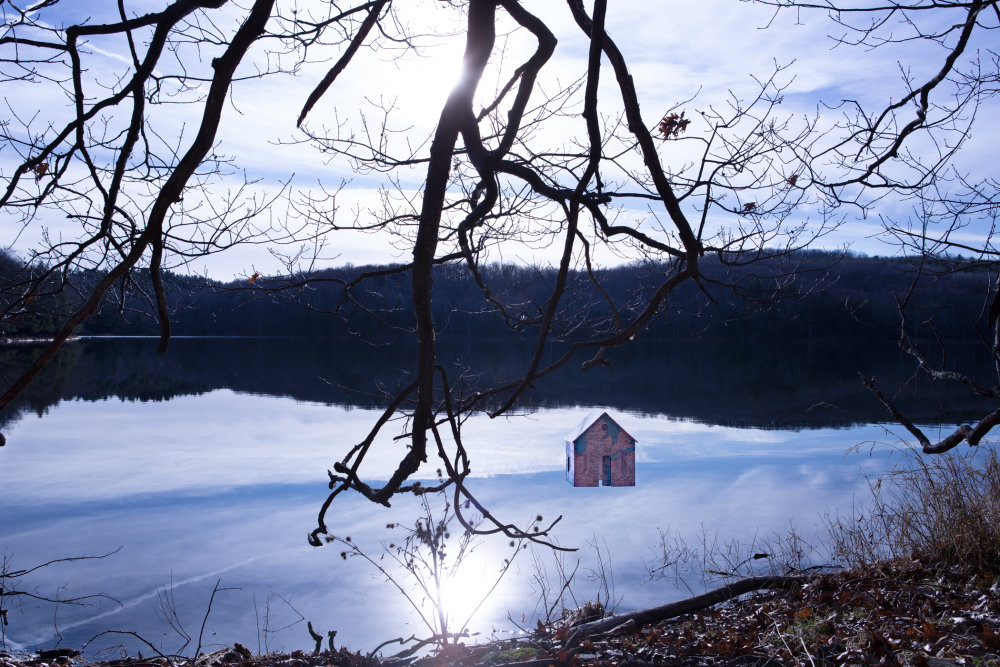
© Jane Szabo, November 23, Forget Me Not (2019)
With the image “November 23, Forget Me Not,” we are reminded that “somewhere else” is not just a wish in the present, but the expectation for the future or a memory from one’s past. Here, the title influences our perception of the image. Forget me not. To not forget, we must have a memory to begin with. The constructed house sits out in a large lake. On the house, the map features clearly evident bodies of water. The house creates no reflection on the water’s surface and seems to float there, weightless. This creates a feeling of suspension in space and suggests a parallel suspension in time where this memory sits, indefinitely, possibly remembered a bit differently from how it actually happened.
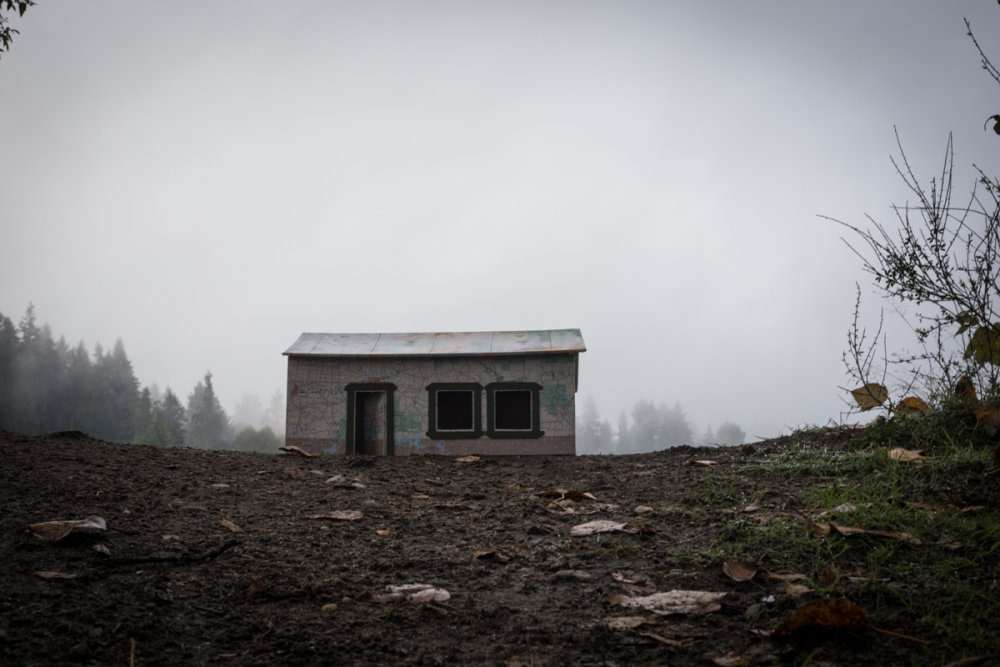
© Jane Szabo, October 27, Phantom Lake (2018)
It is early morning or late in the day at dusk in the image “October 27, Phantom Lake.” The house appears to sit on a ridge. From this vantage point we might feel that there is a broader view of the world around us that we are missing. We might imagine the air to be cleaner and fresher. At night we can see more stars. We sense a breeze, and it appears a little cloudy, barren, and cooler at this higher elevation. There is a feeling of silence, isolation, and seclusion from high above the busy, unending rat-race of life the artist might face daily. It reflects perhaps an aspiration to rise above the noise and the traffic and depart for somewhere quieter and milder.
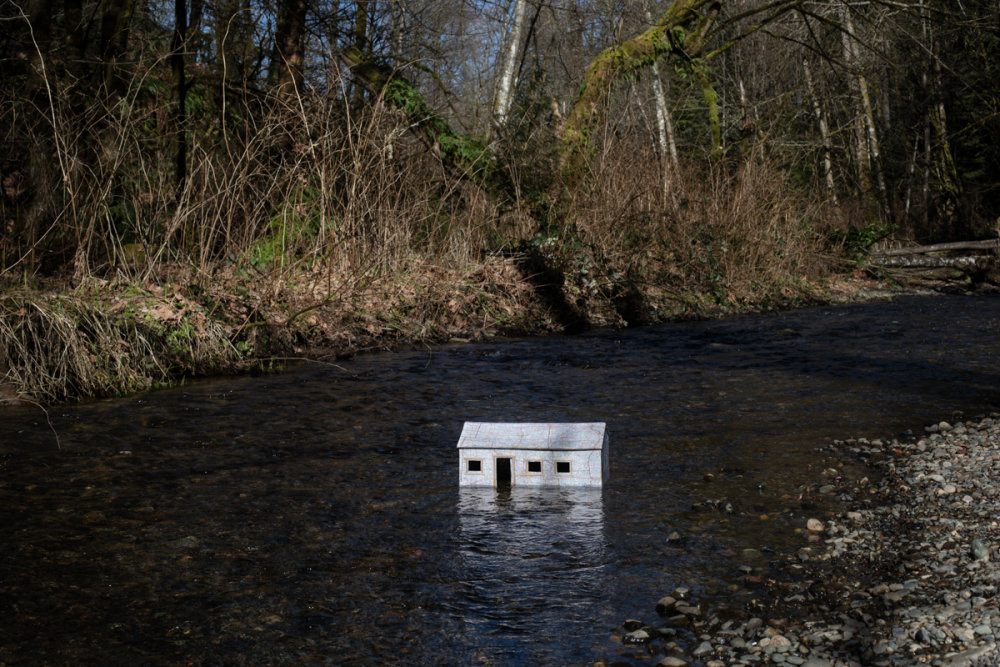
© Jane Szabo, March 2, Coal Creek (2019)
Why, in the staging of “March 2, Coal Creek” would Szabo place a house in the middle of a creek? Is this a visual allusion to being flooded or overwhelmed? Is this a reference to the climate change crisis experienced by many, and denied by others? Or is the artist searching for a memory along a stream? How often have we felt the relaxing rhythm of moving water, listening to nature’s sounds. We presume that this is crystal clear, unpolluted water, untainted by society and unprocessed by a city water system that flushes out of tap where politicians assure us of its safety. Is this a reference to some early childhood experience that is lost and which the artist is trying to reclaim? There is no harsh sunlight, suggesting the atmosphere is cool in mid morning or late afternoon. It gives us a sense of a place deep in the woods. A theme begins to emerge of a need for some place where there is a gentleness, solitude, and quiet.

© Jane Szabo, September 10, River Oaks (2018)

© Jane Szabo, August 30, Silver Cloud (2019)
Several images in the series are of interior spaces where there is an air of relaxation. The interior image “September 10, River Oaks” shows a home floating in a bathtub amidst a fanciful cloud of soap bubbles. The setting reminds us of a spa and a sense of luxury. It evokes that stereotypical image of lounging in a hot bubbly bath. One can imagine the artist feeling stress and desiring relaxation. Whether by coincidence or not, the image “August 30, Silver Cloud” is set in a bedroom, with the sheets turned down, and four luxurious pillows against the head board. The composition seems to suggest that home is where we rest our heads. Unlike the other constructed homes, this one has windows with shutters. Could they exist to close out the light and allow a more restful sleep? Or is it to capture dreams, to close in thoughts and to shut out the worry and anxiety of work? Just like wearing eye shades on a long distance flight, this home’s windows and shutters are a hint for us to close our eyes and imagine “Somewhere Else.”
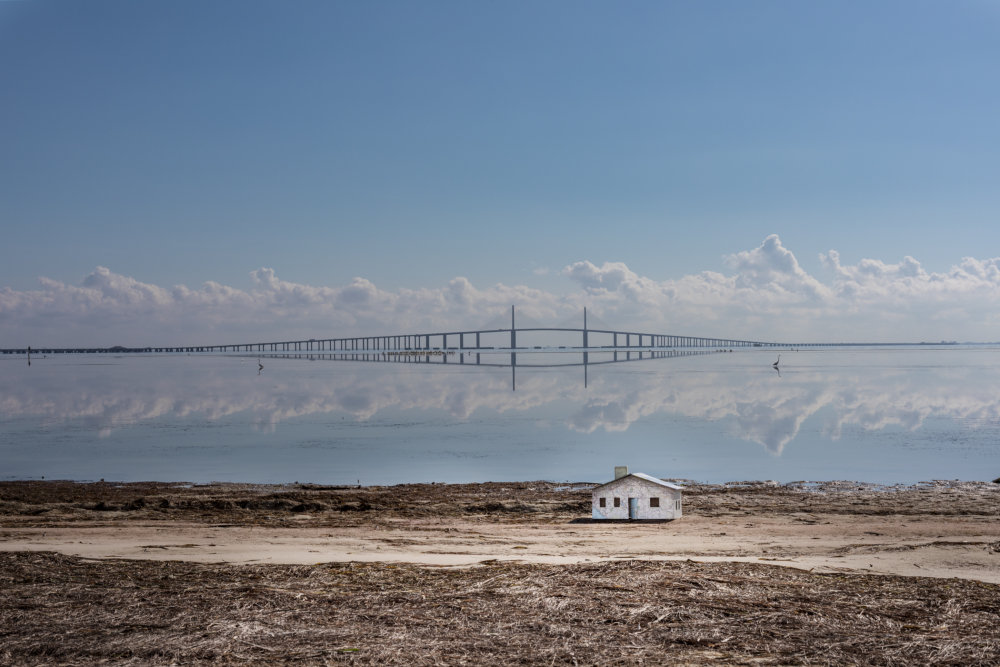
© Jane Szabo, November 10, Sunshine Skyway (2018)
The concept of “somewhere else” in time is not just past, present, future, but also morning and evening. There is a sense of midday in “November 10, Sunshine Skyway.” Two birds float in the water in the far away background in from of a symmetrically rising and descending suspension bridge. The birds face opposite directions. The sky and its clouds are reflected in very flat, still water. The ground around the house has the appearance of an area frequently covered by waters that have since receded. Unlike other imagined locations, this one is not as inviting. It is more a location for visiting. It does not seem like a place one would want to place a home. But the home is not for living. The home is surrogate for our sense of place. In looking over an expanse of water, a bridge rising and falling the the background, we feel a touch of nature, even in a scene gently split by an engineered structure spanning the horizon. The image feels conflicted. Clouds, birds, and water against steel, concrete, and traffic.

© Jane Szabo, June 7, Spy Mountain (2019)
The image “June 7, Spy Mountain” is a beautiful desert-like setting with stars in the night sky over the black outline of mountains in the distance. The constructed house differs from other in the series as it appears to only have maps on its roof, with red brick for walls. The photographer has gently painted the foreground with light to allow the darkness to reveal the home amidst a setting of brown tufts of grass and rock. The map on the roof may hint toward thinking upward toward the stars. Perhaps the artist is suggesting a place we might live, somewhere elsewhere than on this earth. In this place, we ascend into the night sky. Alone in the desert, we would surely feel like we are “somewhere else.”
As conflicted as many of us feel about the present moment in history, Jane Szabo’s tableaus are a thoughtful vehicle to help us journey to “someplace else.” The concept of being elsewhere has multiple dimensions: time, place, and mood. Creating a visual expression of emotions is complex, regardless of the medium an artist uses. There are no maps to follow on an emotional journey. While a house may represent a home or a sanctuary, the maps from which these structures are built will not guide us there. The maps are symbolic of the journey. We know there are places we long to be, literally or figuratively. We have to imagine and find our own way to them. The images Szabo creates are symbolic of that other place, the “somewhere else,” where we feel we could or should be. What these images do is start us on our own journeys by stopping us long enough to reflect upon our situations and consider how her special places might relate to the elsewhere’s of our memories. “Somewhere Else” is the map that offers not a path, but a starting point to set us on our way.
